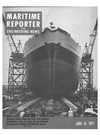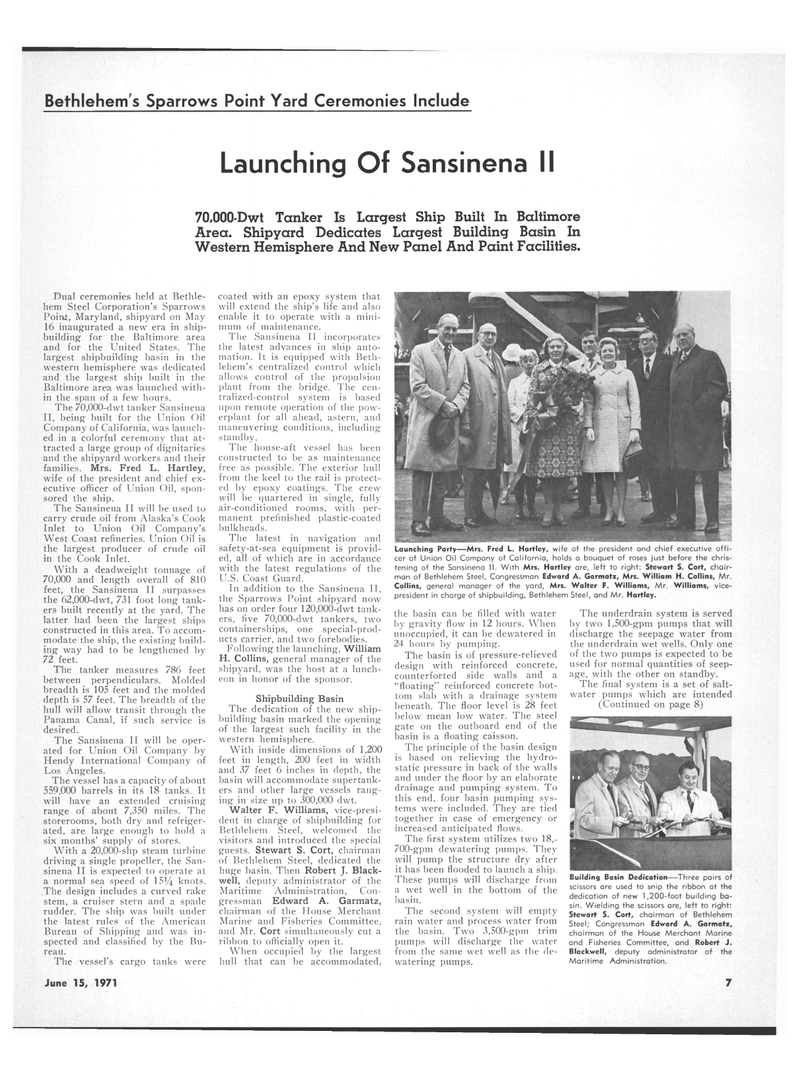
Page 5: of Maritime Reporter Magazine (June 15, 1971)
Read this page in Pdf, Flash or Html5 edition of June 15, 1971 Maritime Reporter Magazine
Bethlehem's Sparrows Point Yard Ceremonies Include
Launching Of Sansinena II 70,000-Dwt Tanker Is Largest Ship Built In Baltimore
Area. Shipyard Dedicates Largest Building Basin In
Western Hemisphere And New Panel And Paint Facilities.
Launching Party—Mrs. Fred L. Hartley, wife of the president and chief executive offi- cer of Union Oil Company of California, holds a bouquet of roses just before the chris- tening of the Sansinena II. With Mrs. Hartley ore, left to right: Stewart S. Cort, chair- man of Bethlehem Steel, Congressman Edward A. Garmatz, Mrs. William H. Collins, Mr.
Collins, general manager of the yard, Mrs. Walter F. Williams, Mr. Williams, vice- president in charge of shipbuilding, Bethlehem Steel, and Mr. Hartley.
Dual ceremonies held at Bethle- hem Steel Corporation's Sparrows
Point, Maryland, shipyard on May 16 inaugurated a new era in ship- building for the Baltimore area and for the United States. The largest shipbuilding basin in the western hemisphere was dedicated and the largest ship built in the
Baltimore area was launched with- in the span of a few hours.
The 70,000-dwt tanker Sansinena
II, being built for the Union Oil
Company of California, was launch- ed in a colorful ceremony that at- tracted a large group of dignitaries and the shipyard workers and their families. Mrs. Fred L. Hartley, wife of the president and chief ex- ecutive officer of Union Oil, spon- sored the ship.
The Sansinena II will be used to carry crude oil from Alaska's Cook
Inlet to Union Oil Company's
West Coast refineries. Union Oil is the largest producer of crude oil in the Cook Inlet.
With a deadweight tonnage of 70,000 and length overall of 810 feet, the Sansinena II surpasses the 62,000-dwt, 731 foot long tank- ers built recently at the yard. The latter had been the largest ships constructed in this area. To accom- modate the ship, the existing build- ing way had to be lengthened by 72 feet.
The tanker measures 786 feet between perpendiculars. Molded breadth is 105 feet and the molded depth is 57 feet. The breadth of the hull will allow transit through the
Panama Canal, if such service is desired.
The Sansinena II will be oper- ated for Union Oil Company by
Hendy International Company of
Los Angeles.
The vessel has a capacity of about 559,000 barrels in its 18 tanks. It will have an extended cruising range of about 7,350 miles. The storerooms, both dry and refriger- ated, are large enough to hold a six months' supply of stores.
With a 20,000-shp steam turbine driving a single propeller, the San- sinena II is expected to operate at a normal sea speed of 15% knots.
The design includes a curved rake stem, a cruiser stern and a spade rudder. The ship was built under the latest rules of the American
Bureau of Shipping and was in- spected and classified by the Bu- reau.
The vessel's cargo tanks were coated with an epoxy system that will extend the ship's life and also enable it to operate with a mini- mum of maintenance.
The Sansinena II incorporates the latest advances in ship auto- mation. It is equipped with Beth- lehem's centralized control which allows control of the propulsion plant from the bridge. The cen- tralized-control system is based upon remote operation of the pow- erplant for all ahead, astern, and maneuvering conditions, including standby.
The house-aft vessel has been constructed to be as maintenance free as possible. The exterior hull from the keel to the rail is protect- ed by epoxy coatings. The crew will be quartered in single, fully air-conditioned rooms, with per- manent prefinished plastic-coated bulkheads.
The latest in navigation and safety-at-sea equipment is provid- ed, all of which are in accordance with the latest regulations of the
U.S. Coast Guard.
In addition to the Sansinena II, the Sparrows Point shipyard now has on order four 120,000-dwt tank- ers, five 70,000-dwt tankers, two containerships, one special-prod- ucts carrier, and two forebodies.
Following the launching, William
H. Collins, general manager of the shipyard, was the host at a lunch- eon in honor of the sponsor.
Shipbuilding Basin
The dedication of the new ship- building basin marked the opening of the largest such facility in the western hemisphere.
With inside dimensions of 1,200 feet in length, 200 feet in width and 37 feet 6 inches in depth, the basin will accommodate supertank- ers and other large vessels rang- ing in size up to 300,000 dwt.
Walter F. Williams, vice-presi- dent in charge of shipbuilding for
Bethlehem Steel, welcomed the visitors and introduced the special guests. Stewart S. Cort, chairman of Bethlehem Steel, dedicated the huge basin. Then Robert J. Black- well, deputy administrator of the
Maritime Administration, Con- gressman Edward A. Garmatz, chairman of the House Merchant
Marine and Fisheries Committee, and Mr. Cort simultaneously cut a ribbon to officially open it.
When occupied by the largest hull that can be accommodated, the basin can be filled with water by gravity flow in 12 hours. When unoccupied, it can be dewatered in 24 hours by pumping.
The basin is of pressure-relieved design with reinforced concrete, counterforted side walls and a "floating" reinforced concrete bot- tom slab with a drainage system beneath. The floor level is 28 feet below mean low water. The steel gate on the outboard end of the basin is a floating caisson.
The principle of the basin design is based on relieving the hydro- static pressure in back of the walls and under the floor by an elaborate drainage and pumping system. To this end, four basin pumping sys- tems were included. They are tied together in case of emergency or increased anticipated flows.
The first system utilizes two 18,- 700-gpm dewatering pumps. They will pump the structure dry after it has been flooded to launch a ship.
These pumps will discharge from a wet well in the bottom of the basin.
The second system will empty rain water and process water from the basin. Two 3,500-gpm trim pumps will discharge the water from the same wet well as the de- watering pumps.
The underdrain system is served by two 1,500-gpm pumps that will discharge the seepage water from the underdrain wet wells. Only one of the two pumps is expected to be used for normal quantities of seep- age, with the other on standby.
The final system is a set of salt- water pumps which are intended (Continued on page 8)
Building Basin Dedication—Three pairs of scissors are used to snip the ribbon at the dedication of new 1,200-foot building ba- sin. Wielding the scissors are, left to right:
Stewart S. Cort, chairman of Bethlehem
Steel; Congressman Edward A. Garmatz, chairman of the House Merchant Marine and Fisheries Committee, and Robert J.
Blackwell, deputy administrator of the
Maritime Administration.
June 15, 1971 7

 4
4

 6
6
